
views
Conditioning Your Horse

Set up a training schedule. You can condition your horse just by running it regularly. However, setting up a plan for how you want to train your horse can help you measure her progress and keep you on task. Keep your training consistent for the first eight weeks. For example, you may want to run your horse every day for this first phase. Once you’ve built up the horse’s endurance, you can decrease the number of training days to four or five. Allot equal amounts of time for warm-up, trotting, loping, long trotting, and cool down. You may want to set a specific distance, such as four miles, and split up each section by miles. Add a variant such as a sprint every couple of days to change the training routine, which can help better develop your horse’s muscles. Observe and note changes to your horse’s condition each week. Reset your goals or training program as needed.
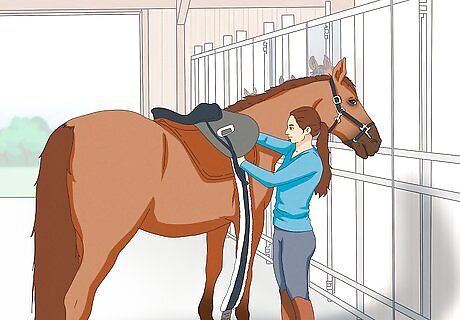
Check your horse’s mount. Comfort is an important factor in your horse’s ability to accelerate and can make conditioning easier for you and her. Make sure her mount is properly fitted and nothing is broken or worn to help ensure your horse is comfortable. An uncomfortable mount could make your horse not want to go faster or move its legs. Check the following items on the mount: Saddle tree, to make sure it doesn’t move Saddle bars, for loose rivets Flaps, for weak or loose stitching Billets, for dryness Stirrups, for dryness and wear Bridle, for rough edges that could harm your horse’s delicate mouth

Warm up your horse. Before you start any conditioning routine or exercises, it’s important to let your horse warm up its legs and body. This can remove lingering soreness or swelling and prevent injury. Allow your horse to walk at a leisurely pace for 15-30 minutes. Consider walking her in both directions as well as in circles. Be careful when making circles with your horse. Keep them gentle and interspersed with straight walking. Circles can be physically hard on your horse.
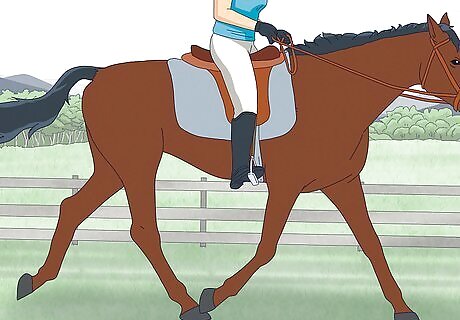
Trot your horse. In order to get your horse into a faster run, it will need to trot for a distance. Trotting is a pace that is faster than a walk but slower than a lope or run. Depending on your training plan, you can trot your horse for a certain time or distance. Encourage your horse to trot with verbal or physical cues such as clucks or a gentle push from the stirrups. Add sprints, or long lopes, to the trotting phase to build your horse’s muscles. For example, you could trot for 30 minutes and then add a one minute sprint followed by another 15 minutes of trotting. Alter this pattern as you and your horse wish.

Increase trotting to a lope. About half of your horse’s training program should be at a lope, or running, pace. Once she is comfortably trotting, cue her to speed up into a run. Break up the loping phase into manageable chunks. For example, you could let your horse lope for a mile and then allow her to trot for a minute or two before starting another mile lope. Be aware that your horse may not be able to lope for long distances if she is in the early phases of training. Either decrease the speed or length until she is ready to lope for a specific time or distance.

Return to a trot. After your horse has loped for the allotted time or distance, decrease the speed into a trot, which some people call breezing. You can break up this phase into two parts for optimal training: the first part can be a long trot and the second part a slow trot. Consider varying the trot with moments of walking or loping to build the horse’s endurance and muscles. Be aware that the long trot after loping can lengthen his stride and help him tuck his belly.
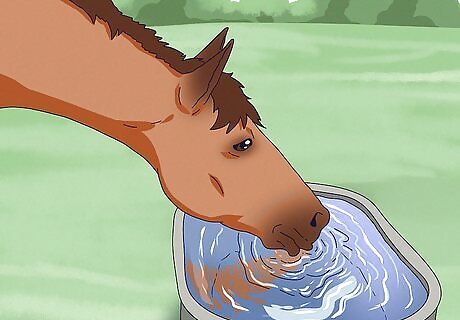
Cool down your horse. Horses can get warm or overheat during training. Cooling your horse down after a good training session can help reinforce the training, remove lactic acid from its muscles, and prevent injuries. Walk your horse as a way to cool it down. Keep the cool down time commensurate with the training. For example, if you increase the speed or distance, you should make sure your horse has more walking time at the end of the session. Give your horse a treat for a good workout and make sure she has fresh food and water, which provide her proper nutrition and hydration and can help her run faster.
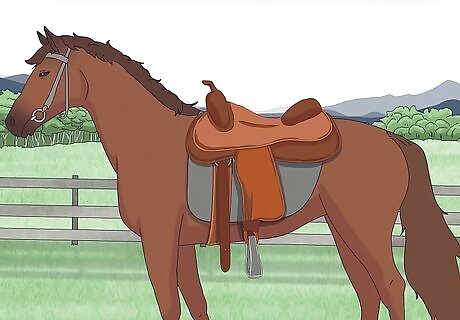
Assess your horse’s condition. After about 45 days, you should be able to see a difference in your horse’s muscle tone and endurance. Take the time to look at the progress your horse has made and adjust your training plan as necessary. Allow your horse sufficient time to rest in between training sessions. This can help prevent injuries. If your horse seems lethargic, has long or dull looking hair, or shows signs of injury such as limping, it may not be rested enough or have a condition that needs immediate medical attention from a vet. Injured ligaments and torn muscles are common in horses that are training too much for their condition. It’s also common for overtrained or out of shape horses to not react quickly to commands or cues. Remember to not push your horse too hard and give it ample time to recover in between sessions.
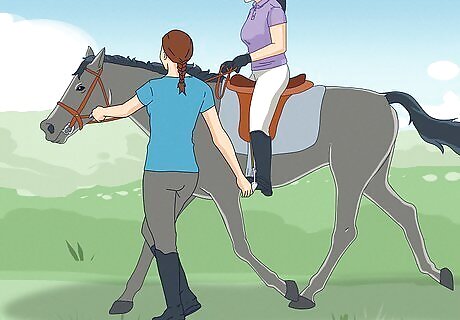
Work with a coach. If you are not an expert at training horses, consider hiring a coach or another horse professional to help you design your training plan. You may want to spend money for a private training session, which can help the coach identify any problems with your horse’s gait or condition. The coach can then suggest a way to remedy the issue and help your horse get faster and stronger. Make a list of questions and concerns you have for the coach. Be sure to include your goals for your horse, a health history, and any other pertinent information. Make sure you are completely honest if the coach asks questions. Not doing so could cause harm to your horse or not effectively get it to the goals you’ve set.
Signaling Your Horse to Accelerate
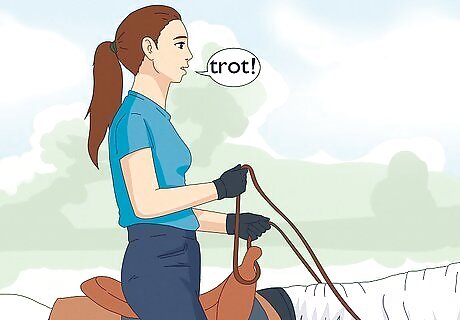
Cue your horse with voice commands. Once of the most simple and effective ways to get your horse to run faster is to command her. Although horses won’t understand words in the same way a human does, they do understand simple commands such as “trot” or “gallop” and even sounds such as clucking or smooching. Make sure to use short and consistent words when cueing your horse. For example, if you want to get her to go faster always use the term “lope” or “run” instead of using them interchangeably. You also need to make sure that you clearly say the words. Watch the tone and pitch of your voice. Keep them soft and gentle because your horse won’t respond to yelling or anger. Back up verbal cues with other aids or signals until your horse runs faster. Once your horse speeds up, you don’t need to give her any further verbal commands until you want her to slow down.
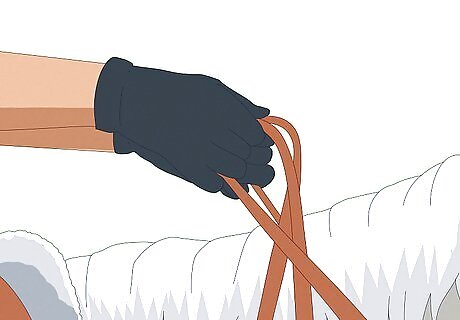
Use hand aids. Your horse’s reins are another way to communicate with her to speed up. In most cases, you will need to combine hand aids with leg aids for the most effective way to communicate your wishes to the horse. The better you know your horse, the more you will understand the most effective hand and leg aids to use. Move your hands in a forward direction along with leg pushing to signals to the horse to lengthen its stride on a trot or lope. Keep your hands level and raised above the horses wither without crossing over the horses neck. Use the hand aid until you’re ready for your horse to slow down.
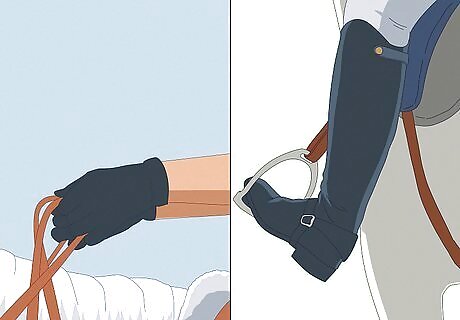
Connect leg aids with hand signals. In most cases, a leg aid is used with a hand aid. The leg aid reinforces commands and can gently nudge your horse forward. Try different combinations of leg and hand commands to see what works best for your horse. Check to make sure your leg is in the proper position when you mount your horse. It should fall right behind the girth strap on the saddle, which spans the largest area of your horse’s body. Apply a gentle inward pressure with your leg or foot to cue your horse to go forward and increase her speed. A light tap also works. If your leg hits your horse’s elbow, adjust it so that it strikes just behind the girth strap. This can prevent miscommunication or injury to your horse. Stop using leg commands once your horse begins running faster. You can use them again when you want your horse to slow down.

Avoid artificial aids. Whips and spurs are man-made aids that some people use to make their horses run faster. However, there is conflicting evidence on whether they’re effective signals for a horse. In addition, they may cause injury or trauma to your horse, which may make her reluctant to run at all. Consider staying away from whips altogether. Evidence suggests that they do not perform better when whipped, but actually worse. In addition, whips can cause harm to your horse if used excessively or on the wrong parts of its body. Wear spurs only if you are an experienced rider. Spurs are worn on the heel to give a more precise leg aid but can cause significant damage to a horse’s side if not used properly.











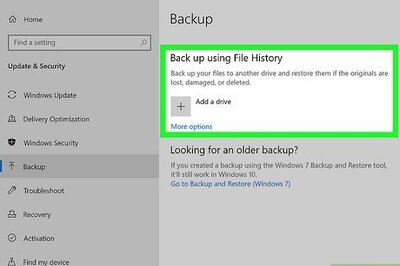


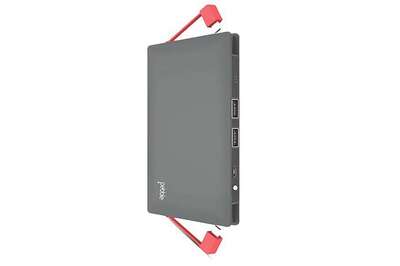




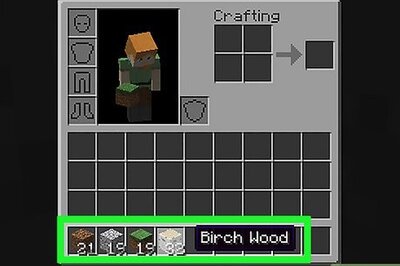
Comments
0 comment